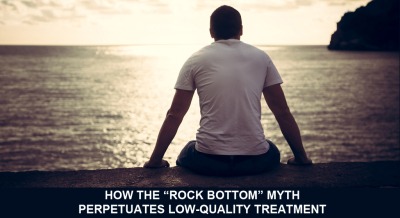“If an addict wants to get sober, they’ll get sober. If they haven’t hit bottom, the best rehab in the world can’t keep them clean for long.”
There’s a common misconception in the addiction field that addicts and alcoholics must hit rock bottom before treatment can be successful. While it’s certainly true that most addicts must suffer considerably before becoming motivated to abstain, “rock bottom” is a highly subjective term that essentially comes down to whenever the addict stops digging – a factor that’s often greatly influenced by the quality of care they receive.
The most dangerous aspect of the “rock bottom” myth is that it has perpetuated the belief that treatment quality doesn’t really matter – that recovery, or lack thereof, depends entirely on the addict’s readiness. This is a convenient scapegoat for treatment centers, allowing them to champion success stories while denying culpability – it’s not our fault your son relapsed, it’s his.
Certainly, if a patient leaves treatment hell-bent on relapsing, their likelihood of remaining sober is slim. But all treatment centers are not the same, just as all brain surgeons are not the same, and some programs work much better than others. Unfortunately, determining rehab quality typically falls to the parents, loved ones, or the addicted patients themselves, who often have little more to go on than a snazzy website and the “gut feeling” they got when speaking to an admissions specialist.
This is a far cry from the rest of the healthcare industry, which has increasingly adopted data-based strategies for measuring and improving treatment results. Patients in need of a gastric bypass can enter their zip code into a database and immediately compare rates of success, complications, and readmissions for local hospitals as well as their practicing surgeons. Couples having difficulty conceiving can locate fertility clinic success rates and drill down based on procedure type or pre-existing conditions. In both of these examples, the doctors’ figures include a myriad of unique situations, complications, and even patient compliance issues, but that isn’t used as an excuse to not track outcomes.
Certainly, the need for outcomes-based addictions care has never been greater. In 2015, the first-ever Surgeon General’s Report on Alcohol, Drugs, and Health was released, revealing that more than 27 million Americans actively misuse prescription and illicit drugs, while more than 66 million people – that’s close to 25% of all adults and adolescents – admitted to binge drinking within the past month. Addiction is costing our country an estimated $442 billion each year, it is wreaking havoc on our society, and it is killing our loved ones in record numbers.
In 2016, exactly 60 years after the American Medical Association officially declared alcoholism a disease, more than 64,000 people died of opioid overdoses alone. That’s more Americans than we lost during the entire Vietnam War. Overdoses now kill more people than guns, more people than car accidents.
While the vast majority of treatment centers employ knowledgeable and qualified staff and provide the best care that they can, there’s no question that low-quality rehabs and halfway houses exist. There have been too many reports of treatment centers mistreating their patients, profiting from insurance fraud and patient brokering, and even committing heinous crimes such as encouraging those with good insurance to relapse so they can re-admit them all over again.
The lack of outcomes data makes it difficult for parents and patients to determine if a treatment center is legitimate. And even when limiting the discussion to high-quality centers, there’s no standard guidelines or regulations when it comes to care, making it difficult to determine best practices for long-term recovery. Each program espouses its own unique philosophy, often – but not always – based on the 12 steps of Alcoholics Anonymous. Group and individual counseling is typically included, but the type and amount vary widely. Even within one treatment center, individual counselors may have wildly different approaches to treatment.
A suggestion that is often made to someone seeking treatment is to ask if a center is following evidence-based practices. But even here, the answer is not as useful as one would like. The Substance Abuse & Mental Health Services Administration (SAMHSA) used to have a National Registry of Evidence-Based Programs and Practices (NREPP) that included reviews of more than 350 different interventions considered to be evidence-based. As if this wasn’t confusing enough, SAMHSA also linked to more than a dozen additional registries with their own lists of approved practices. So if almost every technique can be classified as evidence-based practice, what does the term really tell us?
Frankly, there’s only one good way to truly gauge the effectiveness of different treatment techniques and centers, and that is to monitor and track how many patients are able to become and remain abstinent post-treatment. By helping families identify the treatment programs with the best success rates, outcomes research can help to reverse an epidemic that’s ripping our society apart.
“Rock bottom” describes how people feel in the depths of their addiction. It’s not an excuse to downplay treatment’s accountability when their methods don’t work.








